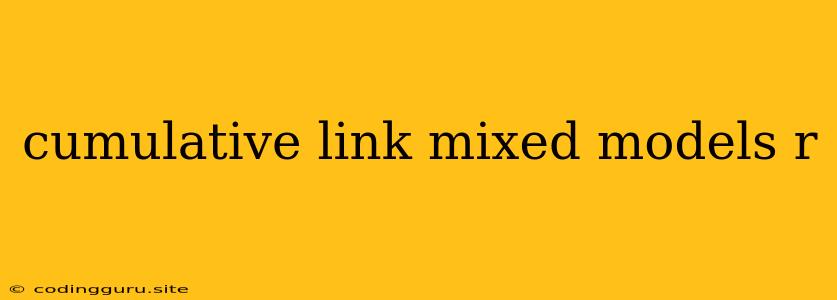Understanding and Implementing Cumulative Link Mixed Models in R: A Comprehensive Guide
The cumulative link mixed model (CLMM) is a powerful statistical tool for analyzing ordinal response variables, especially when dealing with repeated measures or clustered data. This guide will delve into the fundamentals of CLMMs, explore their applications, and demonstrate how to implement them in R.
What are Cumulative Link Mixed Models?
Cumulative link mixed models are extensions of generalized linear mixed models (GLMMs) specifically designed for handling ordinal data. Ordinal data is characterized by categories with a natural order, such as Likert scales (strongly disagree, disagree, neutral, agree, strongly agree), symptom severity levels (mild, moderate, severe), or educational attainment (high school, college, graduate degree).
Here's why CLMMs are particularly useful:
- Accounting for Dependencies: They can model the relationship between an ordinal outcome and explanatory variables, while simultaneously accounting for correlations between observations within the same cluster (e.g., repeated measurements on the same individual, responses from individuals within the same family).
- Addressing Ordinal Nature: They handle the ordered nature of the outcome categories, allowing for a more nuanced analysis compared to treating the categories as purely nominal.
- Flexible Link Functions: They offer different link functions to accommodate the specific relationships between the predictors and the probability of falling into each category of the ordinal outcome.
Key Components of CLMMs
1. Link Function: The link function connects the linear predictor (a combination of explanatory variables) to the probability of belonging to a specific category. Common link functions used in CLMMs include:
* **Logit:** This is the standard choice for binary logistic regression and is often used for ordinal data when the categories are equally spaced.
* **Probit:** This function is similar to the logit, but uses the cumulative distribution function of the standard normal distribution.
* **Complementary Log-Log:** This function is suitable when the categories are ordered but not necessarily equally spaced.
2. Random Effects: These account for the variability between clusters or individuals. They can be specified for different levels of nesting (e.g., individual variation within groups).
3. Fixed Effects: These represent the effects of explanatory variables on the probability of falling into each category of the ordinal outcome.
When to Use CLMMs
CLMMs are the ideal statistical approach when you encounter these scenarios:
- Ordinal Response Variable: Your dependent variable has ordered categories, such as Likert scales, symptom severity levels, or satisfaction ratings.
- Clustered Data: You have observations that are grouped or nested within a higher level (e.g., individuals within families, measurements repeated over time on the same subject).
- Need to Model the Relationship between Predictors and the Ordinal Outcome: You are interested in understanding how explanatory variables affect the probability of falling into each category of the ordinal outcome.
Implementing CLMMs in R
The ordinal package in R provides a powerful and user-friendly function for fitting cumulative link mixed models.
Here's a basic example:
# Load required libraries
library(ordinal)
# Example data
data(wine)
# Fit CLMM with logit link
model <- clmm(quality ~ temp + contact, data = wine, random = ~ 1|bottle)
# Summarize the model results
summary(model)
# Predict the probability of belonging to each category
predict(model, newdata = data.frame(temp = 20, contact = 10), type = "prob")
Explanation:
clmm(): This function from theordinalpackage fits the CLMM.quality: This is the ordinal response variable (e.g., a Likert scale).tempandcontact: These are explanatory variables that are assumed to influence the outcome.random = ~ 1|bottle: This specifies a random intercept for each bottle, accounting for the correlation between measurements from the same bottle.summary(): This provides the model coefficients, standard errors, and p-values.predict(): This function generates predictions for the probability of belonging to each category for new data points.
Tips for Using CLMMs
- Check Model Assumptions: Ensure your data meets the assumptions of CLMMs (e.g., linearity of the relationship between predictors and the logit of the outcome).
- Appropriate Link Function: Choose the link function that best reflects the relationships between the predictors and the outcome categories.
- Random Effects Structure: Carefully consider the structure of your random effects to capture the dependencies within your data.
- Model Selection: Use AIC, BIC, or other model selection criteria to compare different CLMMs and identify the best model.
Beyond the Basics
CLMMs can be extended in several ways:
- Non-proportional Odds: The proportional odds assumption implies that the effect of each predictor is constant across all categories. If this assumption is violated, you can explore models with non-proportional odds.
- Time-Varying Covariates: You can include time-varying covariates (variables that change over time) to model dynamic relationships between predictors and the ordinal outcome.
- Multilevel Structures: For more complex data structures with multiple levels of nesting (e.g., students within classes within schools), you can specify random effects for each level.
Conclusion
Cumulative link mixed models offer a powerful framework for analyzing ordinal response variables in the presence of clustered data. By understanding their structure, components, and implementation in R, you can leverage the flexibility and sophistication of CLMMs to gain insightful and statistically sound conclusions from your data.
